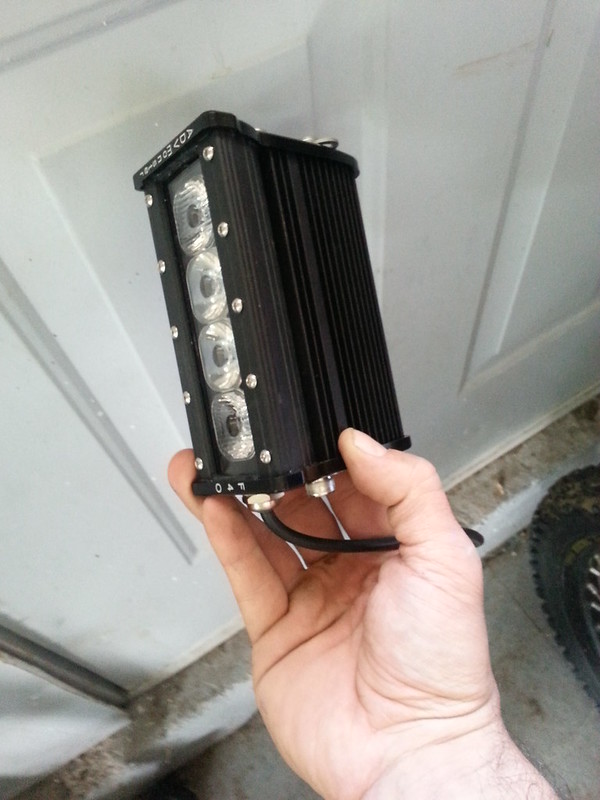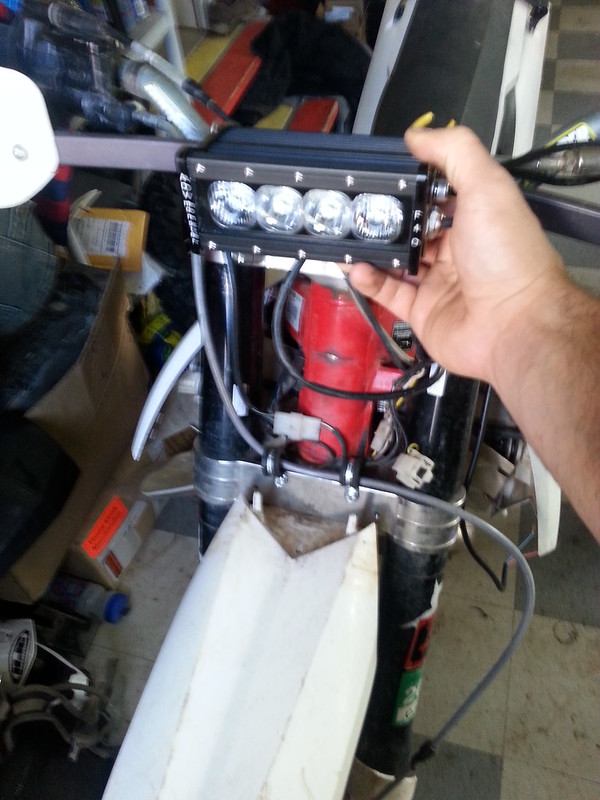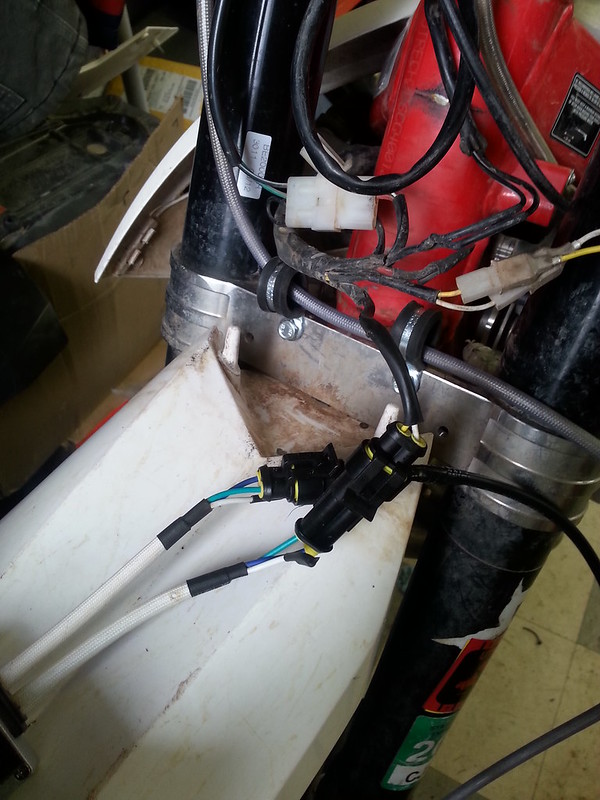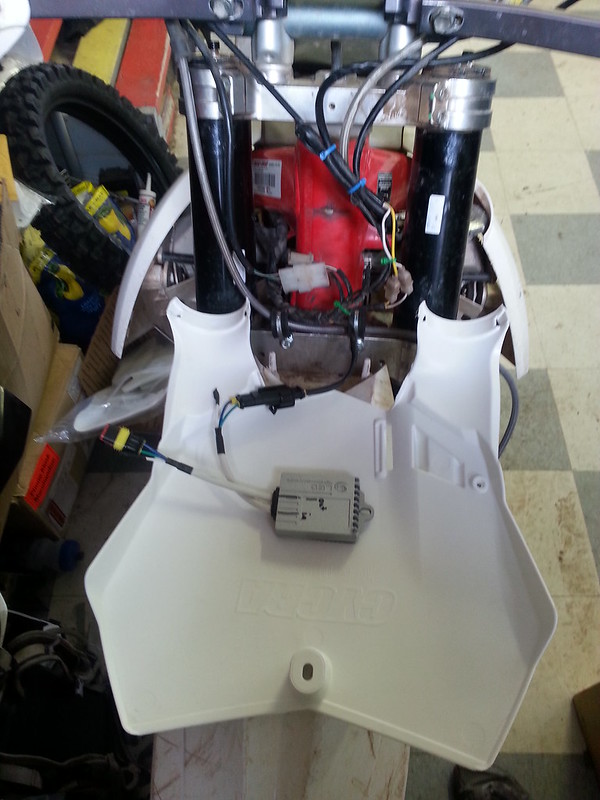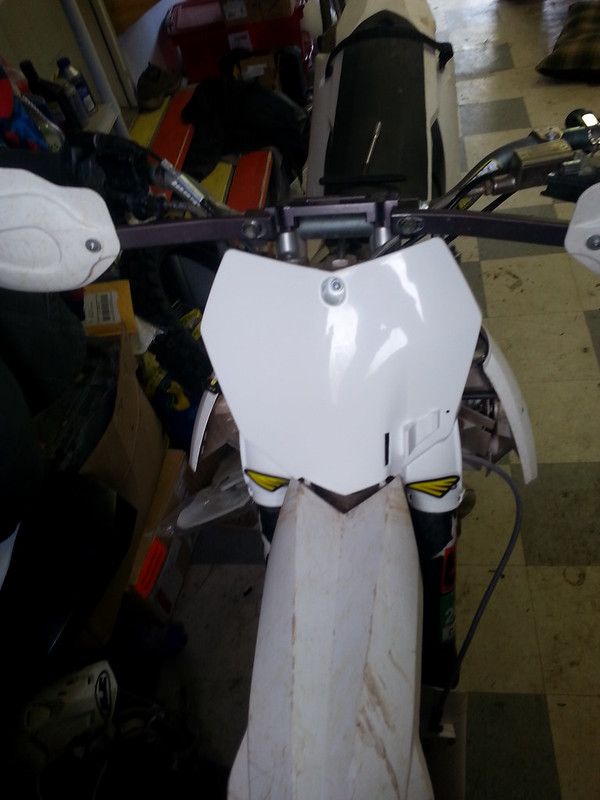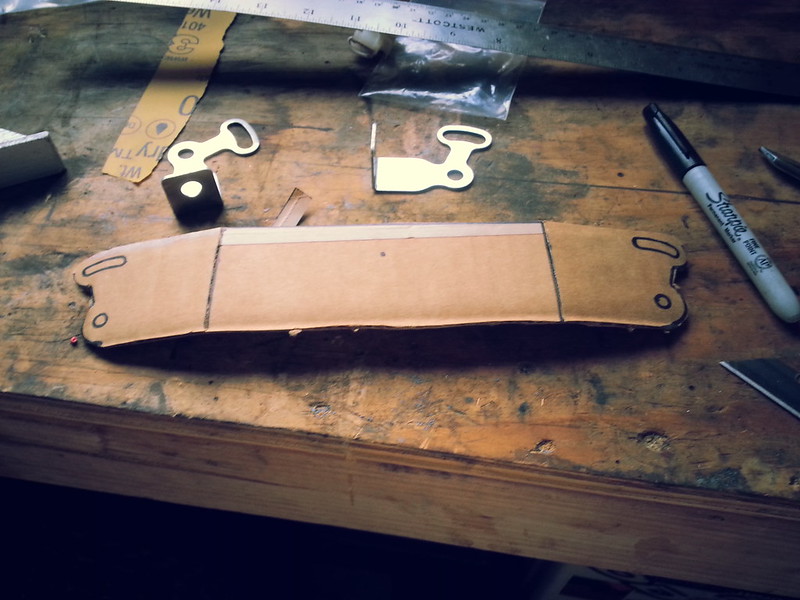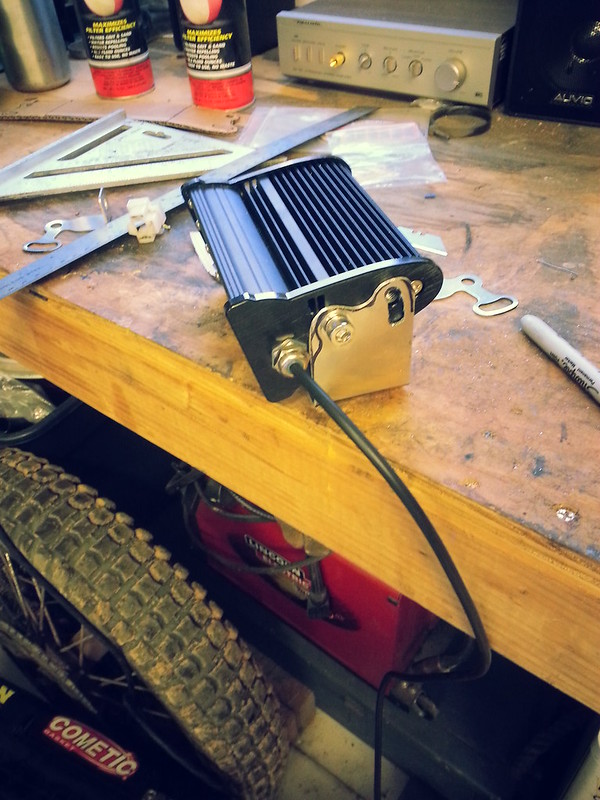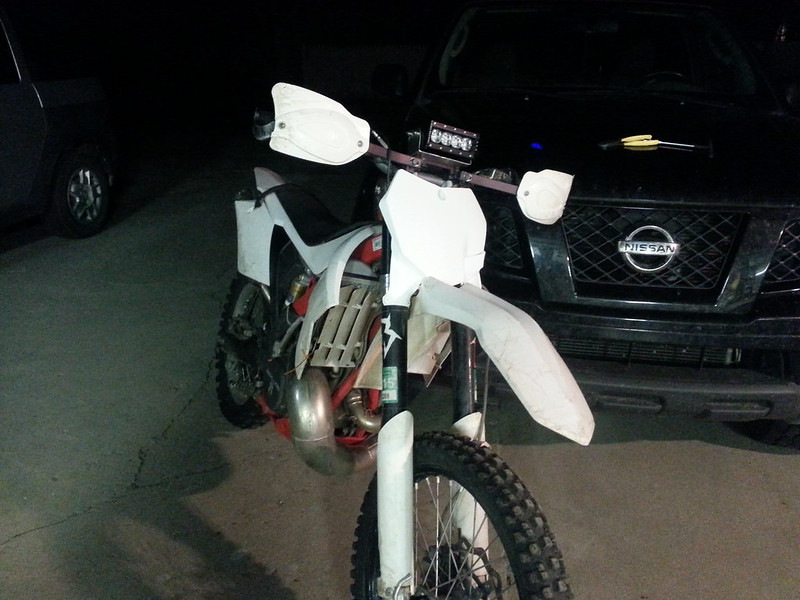VxZeroKnots
Gold Level Site Supporter
Sometimes I find myself still on the bike when it is dark out. On days of particularly bad judgement, i'm just getting started in the dark. Unfortunately, there isn't a dirt bike out there that comes from the factory with a decent headlight for the trail.
Initially I found bike electrical systems to be fairly intimidating and avoided messing with them as much as possible. Okay, fair enough, that is still true but I have gotten a lot more comfortable. That and riding trail in the dark with a weak stock headlight is a powerful motivator
My adventures in electrons with concern to Gas Gas are pretty much all documented in this thread.
I was able to go from the stock nightlight:

To something that was actually usable:
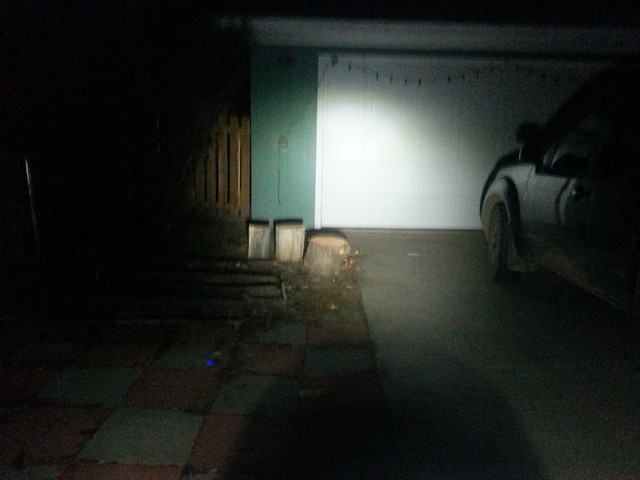

Truth be told I've only ever used this setup once (shown in the last picture) on the trail. It's a good enough system as is to get you out of the woods if you end up out longer than planned but could use some improvement for serious trail riding.
The plan is to try and take the path of least resistance to get a 2012 EC300 to trail worthy night status. Firstoffs I was curious how much juice I had to work with. If I could have my way I wanted to use the cyclops regulator/rectifier that plugs straight into the stock headlight harness. It seems like the LED lights don't really give a shit about voltage variation and don't need a capacitor or battery to operate smoothly.
http://www.cyclopsadventuresports.com/Rectifier-for-LED-Light-Module_p_85.html

I only have the high beam input and output hooked up so I was mainly interested in the DC output from the reg/rec unit on this circuit.
With the bike running on the stand I measured:
Idle: 3.8ADC and 14.2VDC
Reved: 4.2ADC and 13.5VDC
It's a little weird to me that it would make less voltage and more amps at higher revs, but I double checked and have a fairly nice multimeter so... Maybe I did it wrong?
Assuming I didn't that gives me 54-57 watts to work with, more than enough to run pretty much any LED unit out there with room to spare.
I've had Squadrons on two bikes now and they are plenty bright to ride almost anything short of desert racing. They pull 42w/3.8A/12V and put out 4,300 Lumens in a variety of beam patterns. Same with the Squaron XL but with better optics, essentially the same brightness and throw of an 8" HID per their marketing. You pay for those with a $350 price tag for the Squadron-XL and $220 for the Squadron Pro.
Baja designs also makes Sport versions of those same two lights at 20W/1.4A/12V and putting out 1800 lumens. $200 for the XL and $120 for the sport. These are probably sufficient for anything a 300 2T would see.
Finally there is the BD S2, which has a few more lumens. Numbers are 2150 lumens at 21W/1.75A/12V.
Fit and finish is top notch on these and they have built in over voltage protection. The Squadron pro and S2 can be ordered pre mounted in a polisport housing that attaches to the fork with rubber straps.
The other contenders are from www.advmonster.com
the Model 60 puts out 3600 Lumens at 28w/2.4A/12V

This retails for $90 so you get a lot of bang for your buck but have to figure out mounting on your own. There are also two other options with the model 44 and model 30 which draw less, cost less, and put out less but you could always run two of them or mix and match to get exactly what you want at the expense of mounting and wiring complexity.
The choice I'm probably going to go with is the F40 light bar from advmonster @ $150.

It puts out 4000 lumens sucking down 38w@ 12VDC and accepts 9-32VDC. I couldn't find any info on the amps for this unit but it will mount nice over a Honda number plate and I'll remove the stock headlight mask. I like the optic choices on this unit and have found that optics make as much of a difference as the number of lumens put out in terms of useable light.
I hope this post helps someone out and I'll post back as I try stuff out, I'm currently torn between the F40 and S2 in a polisport mask and will try the trailtech reg/rec if the advmonster one doesn't work out...
Initially I found bike electrical systems to be fairly intimidating and avoided messing with them as much as possible. Okay, fair enough, that is still true but I have gotten a lot more comfortable. That and riding trail in the dark with a weak stock headlight is a powerful motivator
My adventures in electrons with concern to Gas Gas are pretty much all documented in this thread.
I was able to go from the stock nightlight:

To something that was actually usable:


Truth be told I've only ever used this setup once (shown in the last picture) on the trail. It's a good enough system as is to get you out of the woods if you end up out longer than planned but could use some improvement for serious trail riding.
The plan is to try and take the path of least resistance to get a 2012 EC300 to trail worthy night status. Firstoffs I was curious how much juice I had to work with. If I could have my way I wanted to use the cyclops regulator/rectifier that plugs straight into the stock headlight harness. It seems like the LED lights don't really give a shit about voltage variation and don't need a capacitor or battery to operate smoothly.
http://www.cyclopsadventuresports.com/Rectifier-for-LED-Light-Module_p_85.html

I only have the high beam input and output hooked up so I was mainly interested in the DC output from the reg/rec unit on this circuit.
With the bike running on the stand I measured:
Idle: 3.8ADC and 14.2VDC
Reved: 4.2ADC and 13.5VDC
It's a little weird to me that it would make less voltage and more amps at higher revs, but I double checked and have a fairly nice multimeter so... Maybe I did it wrong?
Assuming I didn't that gives me 54-57 watts to work with, more than enough to run pretty much any LED unit out there with room to spare.
I've had Squadrons on two bikes now and they are plenty bright to ride almost anything short of desert racing. They pull 42w/3.8A/12V and put out 4,300 Lumens in a variety of beam patterns. Same with the Squaron XL but with better optics, essentially the same brightness and throw of an 8" HID per their marketing. You pay for those with a $350 price tag for the Squadron-XL and $220 for the Squadron Pro.
Baja designs also makes Sport versions of those same two lights at 20W/1.4A/12V and putting out 1800 lumens. $200 for the XL and $120 for the sport. These are probably sufficient for anything a 300 2T would see.
Finally there is the BD S2, which has a few more lumens. Numbers are 2150 lumens at 21W/1.75A/12V.
Fit and finish is top notch on these and they have built in over voltage protection. The Squadron pro and S2 can be ordered pre mounted in a polisport housing that attaches to the fork with rubber straps.
The other contenders are from www.advmonster.com
the Model 60 puts out 3600 Lumens at 28w/2.4A/12V

This retails for $90 so you get a lot of bang for your buck but have to figure out mounting on your own. There are also two other options with the model 44 and model 30 which draw less, cost less, and put out less but you could always run two of them or mix and match to get exactly what you want at the expense of mounting and wiring complexity.
The choice I'm probably going to go with is the F40 light bar from advmonster @ $150.

It puts out 4000 lumens sucking down 38w@ 12VDC and accepts 9-32VDC. I couldn't find any info on the amps for this unit but it will mount nice over a Honda number plate and I'll remove the stock headlight mask. I like the optic choices on this unit and have found that optics make as much of a difference as the number of lumens put out in terms of useable light.
I hope this post helps someone out and I'll post back as I try stuff out, I'm currently torn between the F40 and S2 in a polisport mask and will try the trailtech reg/rec if the advmonster one doesn't work out...
Last edited:

